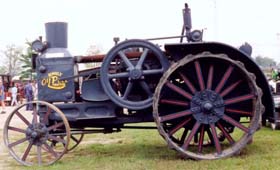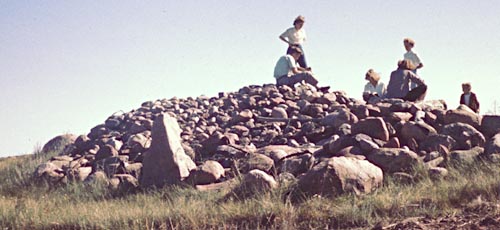Mistakes Made in Alberta
Lloyd was never one to be disrespectful of his father, and even objected if others were. So it seems out of character, in a way, that he concludes his account of life in Excel by setting out to catalog mistakes his father made there. But the things he chooses to mention, and the fact that, in the end, he is able to come up with only four “mistakes,” say as much about Lloyd as about his father.
 | By 1958, the depression in the foreground was all that remained of the wood frame house the Wrights had built on the homestead in 1918, forty years earlier. (The depression was the cellar of the house.) In the background at right (where the people are standing) is the rock pile Lloyd mentions.
Though it is exaggerated by this particular perspective, the elevation difference between the foreground area and the car in the distance (toward upper left) is evident, illustrating Lloyd's point. Not only was it impossible to find a well on this high ground, but it was also necessary to carry the water uphill from the neighbor's well—a climb of at least forty feet in addition to the horizontal distance of half a mile.
| Image credit: Art Wright |
Dad built our home on a higher place and we could never find a well. All our neighbors built their homes on lower areas and nearly all had a good well nearby. We spent eleven years hauling water half a mile when I think we should have attempted to establish a home near the road by our place where there was a much better chance of having a good well. The idea was to have a home that could be seen for miles around. Today there is nothing there but the evidence of mistakes made.
 | Rumley Oil Pull, an early tractor that ran on kerosene | Image credit: Huron Pioneer Thresher &
Hobby Association Inc. |
When first starting there, Dad [broke] the prairie with a four-horse team. (This was not a mistake.) By 1916, some money was made farming wheat. Rather than continuing [to use a team of horses], Dad hired a large Rumley Oil Pull to break the prairie while
It would have been much better to have bought cattle and established a cattle ranch. Continuing as he started was certainly the best way to operate. It meant more labor in one way but very likely
 | The “pile of rock:” the origin of this pile is described in the chapter “Wheat Farming.” It must have been a challenge even for a team of horses to drag some of the larger rocks up the hill.
| Image credit: Art Wright |
I cannot forget that enormous pile of rock and the labor to put it there for nothing. One thing that was taken to Canada in that immigrant car was a hay loader. It had been shipped from South Dakota to Alberta [via Snohomish] and I only remember it being used once after being shipped all that way and breaking down on its first usage. The last I remember it was still sitting around the place rotting and rusting when we left in 1922 for Oregon, virtually never having really been used. It was the only hay loader I remember having seen. I loaded many tons of hay by hand in later years.
There are others but these are the greatest ones. But the neglect to test for water in the most likely place was one of the greatest ones.
Being in a new place, some mistakes [could be expected]. But many did not need to be made.

|





